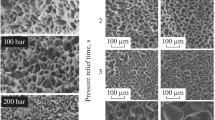Abstract
Polyanionic proteins isolated from biominerals serve as models for the development of biodegradable surface-reactive commercial polymers. A simple model for the natural polyanions is polyaspartic acid. This polymer may be made on a large scale using thermal polymerization of dry aspartic acid. The immediate result of the reaction is polysuccinimide which is hydrolyzed with base to form the polypeptide. The overall process yields up to 99% conversion of aspartic acid to polyaspartate. The thermal polyaspartate (TPA) is a copolymer having 70% of the amide bonds formed from β-carboxyl groups and 30% from α-carboxyl groups. TPA is as effective as the commercial polyanion polyacrylate in mineral dispersion and growth inhibition assays. Biodegradation of the TPA has been established using standard BOD and CO2 evolution assays. In contrast, polyacrylates appear to be non-degradable. Modifications of the TPA have been made by reacting the succinimide with nucleophiles. Crosslinking of the polymer has been achieved, a process which results in absorbent gels. Because TPA can be produced in large scale, has similar activity to polyacrylate and is biodegradable, it seems a likely candidate for use in numerous applications in which non-degradable polyanions are employed. These applications include use as detergent additives, water treatment chemicals, dispersants for the paint and paper industry and as superabsorbents in health and sanitary products.
Similar content being viewed by others
References
A.P. Wheeler and C.S. Sikes, in Biomineralization: Chemical and Biochemical perspectives, edited by S. Mann, J. Webb and R.J.P. Williams (VCH, Weinheim, 1989), p. 95.
L. Addadi, J. Moradian-Oldak, and S. Weiner, in Surface Reactive Peptides and Polymers, edited by C.S. Sikes and A.P. Wheeler (ACS, Washington DC, 1991), p. 13.
C.S. Sikes and A.P. Wheeler, CHEMTECH 18, 620 (1988).
J.E. Borbas, A.P. Wheeler and C.S. Sikes, J. Exp. Zool. 258, 1 (1991).
K.W. Rusenko, J.E. Donachy and A.P. Wheeler, in Surface Reactive Peptides and Polymers, edited by C.S. Sikes and A.P. Wheeler (ACS, Washington DC, 1991), p. 107.
A.P. Wheeler and C.S. Sikes, in Materials Synthesis Utilizing Biological Processes, edited by P.C. Rieke, P.D. Calvert, and M. Alper (MRS, Pittsburgh, 1990), p. 69.
G. Chiaudani and P. Poltronien, Ingegneria Ambientale, No. 11 (1990).
S.W. Fox and K. Harada. in A Laboratory Manual of Analytical Methods of Protein Chemistry. Vol. 4, edited by P. Alexander and H.P. Lundgren (Pergamon Press, Oxford, 1966), p. 127.
L.P. Koskan and K.C Low. U.S. Patent No. 5057597 (1991).
A. Vegotsky, K. Harada and S.W. Fox. J. Am. Chem. Soc. 80, 3361 (1958).
P.D. Hoagland and S.W. Fox, Experientia 29, 962 (1973).
J. Mosig, A.P. Wheeler and C.H. Gooding unpublished data.
H. Pivcova, V. Saudek and H. Drobnik. Polymer 23, 1237 (1982).
E. Kokufuta, S. Suzuki and K. Harada, Bull. Chem. Soc. Jap. 51, 1555 (1978).
A.P. Wheeler, unpublished data.
B.F. Greek. Chem Eng. News. Jan 25, (1988) p. 21.
C.C Pierce and J.E. Hoots, in Chemical Aspects of Regulation of Mineralization, edited by C.S. Sikes and A.P. Wheeler (Univ. of South Alabama Publication Services, Mobile, AL, 1988), p. 53.
Author information
Authors and Affiliations
Rights and permissions
About this article
Cite this article
Wheeler, A.P., Koskan, L.P. Large Scale Thermally Synthesized Polyaspartate as a Biodegradable Substitute in Polymer Applications. MRS Online Proceedings Library 292, 277–283 (1992). https://doi.org/10.1557/PROC-292-277
Published:
Issue Date:
DOI: https://doi.org/10.1557/PROC-292-277




